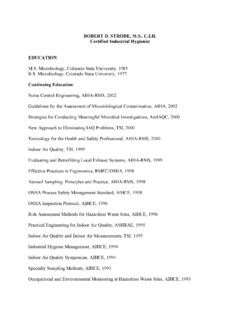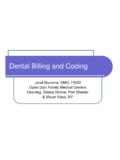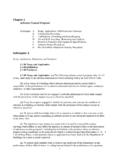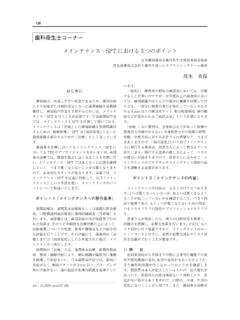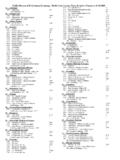Transcription of about silicosis in the ready mix industry NOT JUST …
1 IT S NOT JUST DUST .. It s Silica! What you should know about silicosis in the ready mix industry Illinois Onsite Safety & Health Consultation Program Contents Introduction _____ 1 What is silicosis ? _____ 2 silicosis is a lung disease caused by breathing dust containing particles of crystalline silica. Who should be concerned about silicosis ? _____3 The ready mix industry should be concerned about silicosis when chipping out the mixer. How do you determine if you have a problem? _____3 Review material safety data sheets to determine if silica is present in the materials you use. How much crystalline silica is hazardous? _____ 4 The answer depends on a worker s exposure level and on a calculation of the Permissible Exposure Limit (PEL).
2 Determining when crystalline silica dust is hazardous _____5 Here s how an industrial hygienist might use the PEL to find out if a worker is overexposed to crystalline silica dust and how the PEL is used in determining overexposure to silica dust. IRMCA Industrial Hygiene Study _____7 Permit Entry and Lockout Procedures for entry into truck mixer _____19 Here are the procedures for reclassifying the ready mix truck into a non-permit confined space and the procedures for control of hazardous energy sources. Getting Help_____21 Study Results page 7 Modified Chipper page 10 Conclusion page 7 Noise Results page 11 Validation page 8 Various Control Methods page 12 Engineering Controls page 9 Data Tables page 15 1 Illinois Onsite Safety & Health Consultation Program Silica and the ready Mix industry Introduction silicosis is an occupational disease caused by exposure to dust from crystalline silica, one of the most common minerals on our planet.
3 silicosis isn t curable! Workers are still dying from the disease. This condition is preventable. The keys to prevention are straightforward: about crystalline silica What is it? Crystalline silica is the scientific name for a group of minerals containing silicon and oxygen. Crystalline means that the oxygen and silicon atoms are arranged in a specific pattern. Forms of crystalline silica Crystalline silica exists in several forms, including quartz, cristobalite, and tridymite. Tridymite is the most potent, but least common form. Cristobalite, which oc-curs naturally in volcanic rock, is often found with quartz in the Pacific Northwest. Of these forms, quartz is the most common; in fact, it s the second most com-mon mineral on the planet.
4 (Feldspar is the most com-mon.) The cause of silicosis is linked to cancer Crystalline silica causes silicosis , but it has also been linked to cancer. Any material that contains more than percent crystalline silica must meet the labeling, information, and training requirements of the Hazard Communication Standard, 29 CFR ). identify workplace activities that produce crystalline silica dust and then eliminate the dust or control it so that workers aren t exposed. In the ready mix industry , you often use products or materials that contain crystalline silica and should be concerned about silicosis and crystalline silica hazards. This workbook will inform you about the hazards in your industry so that you can control them.
5 Introduction 2 Illinois Onsite Safety & Health Consultation Program Silica and the ready Mix industry silicosis What is silicosis ? silicosis is a progressive, disabling lung disease caused by breathing dust containing particles of crystalline silica particles so small you can see them only with a microscope. The cause of silicosis has been known for centuries the earliest cases of silicosis were re-corded before the first century yet workers continue to die every year from the disease. Crystalline silica can cause silicosis only when we breathe it into our lungs as dust or a fine powder. Here s what happens: The silica particles become trapped in the lungs and damage the tissue.
6 As a result, the lung tissue scars and forms small, rounded masses called nodules. Over time, the nodules grow, making breathing increasingly difficult. Though silicosis shows no symptoms at first, after a few years the victim eventually has trouble breathing and develops a severe cough. Other symptoms include fatigue, loss of appetite, chest pains, and fever. Only a complete work history, a chest X-ray, and a lung-function test will determine whether or not a worker has the disease. Those who think they may have silicosis should see a medical doctor who specializes in occupational medicine. The respiratory system consists of four main regions: Nasopharyngeal Nasal passages and pharynx Tracheobronchi Wind pipe (trachea) and its main upper branches (bronchi) Bronchioles Smaller branches called bronchioles Alveoli The smallest branches in which the lung terminates 3 Illinois Onsite Safety & Health Consultation Program Silica and the ready Mix industry Who should be concerned?
7 Any worker exposed to dust containing crystalline silica dust from crushed rock, soil, dirt, gravel, or sand, for example should be concerned about silicosis . Because crystalline silica is such a common mineral so prominent in the products that we make and use you should be concerned about working with any material that contains more than percent crystalline silica. How do you determine if you have a problem? Do you know what activities at your workplace expose workers to crystalline silica dust? Suspect any activity that produces dust from rock, soil, dirt, gravel, sand, or any product made from these materials. Obtain a material safety data sheet for the products you use to determine if they contain crystalline silicia.
8 In ready mix operations, the employee who chips out the truck is usually at risk. Chronic silicosis silicosis can affect you in three ways. Most workers who get silicosis don t show any symptoms for 10 or more years. That s because their exposures to crystalline silica are fairly low, but frequent. They develop a condition called chronic silicosis . Accelerated silicosis As exposure levels increase, however, silicosis symptoms can appear much earlier. For example, those diagnosed with accelerated silicosis show symptoms within five to 10 years. Acute silicosis Workers exposed to extremely high levels of crys-talline silica dust may develop acute silicosis , a con-dition that can show symptoms within only a few weeks of an initial exposure.
9 Acute silicosis is most common among sand blasters because of the high levels of silica dust they breathe. Work Activities Material Safety Data Sheets These sheets contain data for all materials or products containing hazardous substances that are used at a busi-ness in quantities greater than what a consumer would use. If a material or product contains crystalline silica in quantities greater than , there must be a safety data sheet for it. Manufacturer's responsibility: obtain or develop a safety data sheet for each hazardous chemical they pro-duce or import. Employer's responsibility: ensure access to safety data sheets for all hazardous materials at the workplace. Now that you suspect silica is being used and that it may be in the air, you need to know just how much is there.
10 An industrial hygienist can help you make that determination by sampling the air workers breathe and calculat-ing a Permissible Exposure Limit (PEL). Concern 4 Illinois Onsite Safety & Health Consultation Program Silica and the ready Mix industry Collection of a sample Laboratory analysis of that sample Measuring the Amount of Airborne Silica In order to find out the silica concentration level, two things need to happen: How much crystalline silica is hazardous? Unfortunately, this is not a simple answer that you can apply to every task or workplace. How much crystalline silica is hazardous depends on your exposure and on a calculated value called the permissible exposure limit. The permissible exposure limit (PEL) is the maximum amount of airborne crystalline silica dust that a worker can be exposed to during a full work shift.

